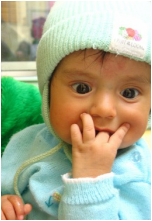Attachment theory and neurobiology explain how our internalized attachments of early primary caregiving relationships affect how we feel about ourselves in the world and how we conduct ourselves in relation to this sense of ourselves.
|
Attachment experiences with a caregiver who can consistently read, validate and reflect back the baby’s cues in a an attuned, collaborative dialogue, is what provides security and regulates the baby’s nervous system.
|
A dependent baby’s whole being and sense of well-being depends on the baby’s connection to the people that take care of him or her. The necessity to be attached to the caregiver is hardwired into the baby's neural system for survival. Mirror neurons cause the baby and caregiver to mutually influence each other’s neural firing and body regulation of emotions. During the critical period of attachment formation, identity is body-based and memory is "behavioral/enacted" and not mental or narrative (Brown & Elliott, 2016, p.284).* The baby’s body senses the intentionality of expression, gesture, and tone of voice of the caregiver and responds with a sense of safety or threat. It is these preverbal experiences with the caregiver that enables the baby to feel safe, secure, loved, and lovable, and that shape the baby’s brain development so as to enable the baby to develop the ability to regulate feelings and have a felt sense of security.
|

However, suboptimal attachment experiences (for example, by caregivers who are dysregulated themselves or by caregiver-baby pairs who are not attuned for temperamental or other reasons) create in the baby distress and angry protest, an autonomic nervous system sympathetic response, followed by primal panic and terror.

When a panicked baby, who can neither fight nor flee, cannot discharge the high arousal, the baby then responds parasympathetically with physiological constriction and freeze, a dorsal vagal response.
Because losing attuned connection to his caregivers jeopardizes and threatens him, the baby learns to adapt to the responses of his caregivers in order to maintain connection with them, in order to survive. This is how the baby, at a time before he has conscious memory, develops coping strategies to tolerate strong emotions and reduce the feeling of being helpless and psychologically alone in the world—coping strategies which are not stored as visual or verbal memories, but rather in the form of body memories--felt experiences of sensation, emotion, and action tendencies.

For example, when a baby consistently tenses in response to unpredictable or alarming caregivers, muscle memories of tensing may become encoded in the baby’s body as a lifelong tendency in attachment relationships. The baby’s body and brain has stored response “memories” of nervous system arousal, perceptions, and response patterns of muscles.
These attachment experiences are also what "wires in" the baby’s “window of tolerance” for emotions and arousal, a range in which intensities of feeling can be experienced without disrupting the ability to think, feel, behave and connect with others effectively.
“Within the boundaries of the window of tolerance, the mind continues to function well. Outside these boundaries, function becomes impaired” (Siegel, 1999, p. 254).** Suboptimal attachment experiences in early childhood result in compromised development of the brain’s ability to regulate strong emotions and stress. When an emotion pushes a person out of their window of tolerance, it creates difficulty-- with thinking, behaving, feeling present and/or connecting.**
The procedural and emotional memories stored in the body in childhood are experienced as action tendencies and as emotional reactions--independent of the events that shaped them, and without declarative memory. These sensations and emotions are experienced as terrible, can feel all but impossible to manage, and can take over the body in seconds. When confronted with disappointment or with fear in a current situation, these body and emotional reactions can occur, and can carry the same interpretations and same action tendencies of childhood, whether it fits the current situation or not. Because these experiences were not stored in conscious language/ image-based memories, we may not realize that the reaction we are having doesn’t fit. We may have no "stimulus discrimination"—discriminating between threats which warrant such an intense reaction and those which don’t, but feel like they do because of the past.
Thus, our ability to tolerate strong emotions—an ability wired in long ago outside of our awareness--can leave us vulnerable to devastating distress and action tendencies as adults when close relationships feel threatened or threatening. We are dysregulated by attachment hopes and fears which are reminders of the original attachment disruption.
The procedural and emotional memories stored in the body in childhood are experienced as action tendencies and as emotional reactions--independent of the events that shaped them, and without declarative memory. These sensations and emotions are experienced as terrible, can feel all but impossible to manage, and can take over the body in seconds. When confronted with disappointment or with fear in a current situation, these body and emotional reactions can occur, and can carry the same interpretations and same action tendencies of childhood, whether it fits the current situation or not. Because these experiences were not stored in conscious language/ image-based memories, we may not realize that the reaction we are having doesn’t fit. We may have no "stimulus discrimination"—discriminating between threats which warrant such an intense reaction and those which don’t, but feel like they do because of the past.
Thus, our ability to tolerate strong emotions—an ability wired in long ago outside of our awareness--can leave us vulnerable to devastating distress and action tendencies as adults when close relationships feel threatened or threatening. We are dysregulated by attachment hopes and fears which are reminders of the original attachment disruption.
The intense and painful feelings can in themselves cause fear.
Feelings that are so overwhelming that they break through our "window of tolerance" can be feared in themselves to be unbearable. These emotions can “leave us feeling helpless to avoid or stop [them] and powerless to get away from [them]” (Fosha, 2000, p. 80-81).*** Symptoms of extreme distress, such as insomnia, pounding heart, disorganized thoughts, fear, anxiety, intrusive thoughts and memories can result when people are pushed out of the top of the window of tolerance into the sympathetic hyperarousal zone; and symptoms of collapsing into numbness, extreme tiredness, shock, memory problems, dizziness, and lack of motivation can result when people are pushed outside the bottom of the window of tolerance into the parasympathetic hypoarousal zone. We can develop negative attitudes towards the emotions that we don't like and can't tolerate, and may try to avoid feeling them at all costs. However, turning away from or fighting painful emotions can actually cause us to become more stuck in them.
“The attempt to escape from pain is what creates more pain.”
--Sogyal Rinpoche
--Sogyal Rinpoche
Neuroplasticity is the good news.
The latest neuroscience research proves that it is absolutely possible to widen our “window of tolerance." We can change coping patterns that may no longer serve us and can connect to our true selves by consciously rewiring our brain through new positive experience and through awareness. Neuroscience proves that the brain has the lifelong capacity to be rewired if new experiences and new learning challenge the habitual body responses. As a result, old behaviors and thinking can be changed in a way that creates resilience in responding to life’s challenges and everyday disappointments.
When we learn how to actually experience and regulate our intense emotions in our bodies and tend to the parts of ourselves that are crying out, we can transform anger into assertiveness, fear into self-protection, grief into acceptance, self-hatred into self-compassion, and apathy into passion. In doing so, we can move from surviving to thriving.
During the process of therapy, you can explore and change somatic responses and habitual patterns and beliefs, and process stuck emotions.
During the process of therapy, you can explore and change somatic responses and habitual patterns and beliefs, and process stuck emotions.
"I’ve learned that people will forget what you said, people will forget what you did, but people will never forget how you made them feel."
— Maya Angelou
|
|
"History, despite its wrenching pain, cannot be unlived, but if faced with courage, need not be lived again."
— Maya Angelou
"The real voyage of discovery is not in seeking new places, but in seeing with new eyes."
— Marcel Proust
Resources
*Brown, D.P. & Elliot, D.S. (2016). Attachment disturbances in adults: Treatment for comprehensive repair. New York: Norton & Co.
***Fosha, D. (2000). The transforming power of affect: A model for accelerated change. New York: Basic Books.
**Siegel, D. (1999). The developing mind. New York: Guildford Press,.
***Fosha, D. (2000). The transforming power of affect: A model for accelerated change. New York: Basic Books.
**Siegel, D. (1999). The developing mind. New York: Guildford Press,.
Copyright 2015-2025 by Patricia Dallacroce, JD, MA, LMFT, all rights reserved



